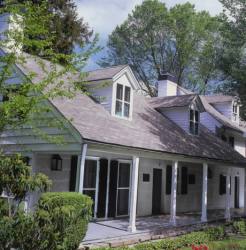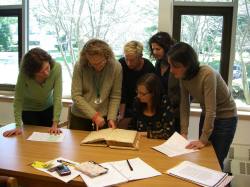The Slaves of Scarsdale
- Category: Schools
- Published: Wednesday, 13 October 2010 18:25
 If you thought that slavery, or the peculiar institution, had no history in Scarsdale, read ahead. It turns out that slavery in Scarsdale is as old as Wayside Cottage. In fact, Thomas Hadden, who may have been the original resident of Wayside Cottage was a very prolific man who had three children by his wife plus five more with his “Wench Rose”, the family’s slave. Rose’s children, Amos, Lazerus, Dinns, Jacob and Eleanor are all listed as beneficiaries in Hadden’s will, which was handwritten and dated 1761. Unlike Thomas Jefferson who is said to have kept his relationship with slave Sally Hemmings under wraps, the Hadden will is upfront about the “Wench” and her children and stipulates that they are to be freed upon Hadden’s death and each is to be given 25 pounds of good and lawful money.
If you thought that slavery, or the peculiar institution, had no history in Scarsdale, read ahead. It turns out that slavery in Scarsdale is as old as Wayside Cottage. In fact, Thomas Hadden, who may have been the original resident of Wayside Cottage was a very prolific man who had three children by his wife plus five more with his “Wench Rose”, the family’s slave. Rose’s children, Amos, Lazerus, Dinns, Jacob and Eleanor are all listed as beneficiaries in Hadden’s will, which was handwritten and dated 1761. Unlike Thomas Jefferson who is said to have kept his relationship with slave Sally Hemmings under wraps, the Hadden will is upfront about the “Wench” and her children and stipulates that they are to be freed upon Hadden’s death and each is to be given 25 pounds of good and lawful money.
The will, and many more 17th and 18th century documents about Scarsdale’s first residents and their slaves are being unearthed and analyzed as part of an imaginative original research project led by Middle School Librarian Elizabeth Waltzman. She is working with a team of seventh grade English, Social Studies and Humanities teachers and their students to learn about Scarsdale’s slaves, the last of whom died or were freed in 1835, before the Civil War.
With the assistance of Eric Rothschild the team visited the Scarsdale Library. Their quest continued with visits to Scarsdale Village Hall and the Westchester County Archives and Historical Society to find original documents that the students can examine for clues about slavery in the early years of Scarsdale.
 The impetus for the project is a planned visit on October 27 by author Marilyn Nelson who will discuss her book, Fortune’s Bones. Nelson a former poet laureate from Connecticut has written an elegy to a former slave from Waterbury. Fortune was a man who was enslaved to a Dr. Porter in the late 1700s. When Fortune drowned, Porter boiled and stripped the body and turned the skeleton into an anatomy display, which is now the property of the Mattituck Museum. In her book, Nelson juxtaposes pictures from the anatomy display against poems that elegize Fortune’s life. The book is called a Manumission Requiem, as manumission is the process by which slaves were freed.
The impetus for the project is a planned visit on October 27 by author Marilyn Nelson who will discuss her book, Fortune’s Bones. Nelson a former poet laureate from Connecticut has written an elegy to a former slave from Waterbury. Fortune was a man who was enslaved to a Dr. Porter in the late 1700s. When Fortune drowned, Porter boiled and stripped the body and turned the skeleton into an anatomy display, which is now the property of the Mattituck Museum. In her book, Nelson juxtaposes pictures from the anatomy display against poems that elegize Fortune’s life. The book is called a Manumission Requiem, as manumission is the process by which slaves were freed.
Taking their lead from Nelson, the SMS librarian and teachers are searching for original documents that provide information about slaves in Scarsdale, which the students will analyze and use to draw inferences about slaves lives here. Among the documents to be examined are census reports, wills, ad for slaves, maps, newspaper clippings and property deeds. Part of the goal of the project is to emphasize the use of primary sources in research, as secondary sources are sometimes erroneous or incomplete.
After the research phase, students may be asked to create their own elegy for a slave they identify in history and the entire project may be put together in an online exhibit. This exercise in critical thinking will be undertaken by the 240 students in the classes of Denise Del Balzo, Meghan Lahey, Marci Rothman and Meghan Troy.
The group is busy uncovering many fun facts, some which link Scarsdale to the history of the new nation. For instance:
- Caleb Heathcote founded Scarsdale in 1701. By 1712 the entire population of Scarsdale consisted of 12 people, 8 of whom were slaves. Heathcote later became the mayor of New York City.
- Another famed Scarsdale resident was Daniel Tompkins. He went on to become the Governor of New York State and the Vice President of the United States under President James Monroe. A slave owner, Tompkins drafted legislation to gradually phase out slavery in 1799.
- The total population in Scarsdale in 1790 was only 281 people, of which 22 were slaves. And 45 years later, it remained stagnant with a total of 345 people, including 33 freed slaves or indentured servants.
 If you are aware of any original documents involving slavery in town, please comment below and we’ll pass the information onto the Middle School.
If you are aware of any original documents involving slavery in town, please comment below and we’ll pass the information onto the Middle School.







